Aesthetical Appeal and Dissemination of Architectural Heritage Photographs in Instagram
Abstract
1. Introduction
- Section 2 deals with the literature background concerning the technical elements of the research, mainly focused on visual resources of building photos posted on Instagram. It includes the image social meaning generation in IBSN, the aesthetical appeal of pictures (referred to color and composition) and the dimension of human being in architecture.
- Section 3 covers the materials and methods, including the explanation of the non-experimental research design, to analyze the social perception of architectural heritage on Instagram, as well as how the aesthetic appeal of pictures influence their dissemination within the social network. It also describes the research variables and how they were categorized, comprising the Instagram user profile, the degree of dissemination, the typology of architectural heritage and the aesthetical appeal features of the picture.
- Section 4 addresses the results based on statistical analysis which mainly focus on two types of analyses. First, contingency tests offer the description of the message depending on the Instagram user profile. Second, non-parametric tests assess whether the aesthetical appeal features are related to the degree of dissemination of architectural heritage pictures.
- Section 5 provides a discussion on the findings in relation to the literature, and some practical actions are provided so government agents can promote the conservation of architectural heritage through image-based social networks. These proposals incorporate both the replication of the research method to diagnose the degree of visibility of a specific case and the application of the aesthetical appeal features.
2. Literature Background
2.1. Image Social Meaning Generation
2.2. Aesthetical Appeal: Color and Composition
2.3. Human Figure and Architecture
3. Materials and Methods
Variables
4. Results
4.1. Building Typology, Element Detail and User Account: Contingency Analysis
4.2. Normality and Variance Test
5. Discussion and Conclusions
- Public institutions dedicated to the conservation of architectural heritage should use image-based social networks such as Instagram in an educational way, since it is currently one of the most important social information carriers for youth. The change of platform involves adapting to how users experience it, rather than filling it with content. In this case, the use of own hasthtags and others from related communities should be encouraged to increase visibility towards networks with an interest in heritage that enhances social interaction.
- When promoting architectural heritage in image-based social networks, some aesthetic factors must be taken into account to produce images that can help reach a wider audience. The use of one vanishing point perspective is one of the most effective features due to the screen size where image-based social network runs, which entails positioning the point of interest within the device. However, other characteristics such as color and human dimension should not be a limitation in terms of its ability to spread. Instead, a criterion based on the feeling of closeness or cultural identity that they can convey should be considered, keeping in mind the objective of increasing population awareness towards architectural heritage.
- This research design is available to be replicated by governments and public institutions to diagnose to what extent its architectural heritage is visible in these media. Consequently, they should manage strategic plans to promote those elements with less visibility, without controlling the content generated by the population, but with the aim of complementing the information.
- This research can also serve as an example to trainers and teachers to educate students on how information can be biased in digital environments and how it can lead to the loss of an element as important as heritage.
Author Contributions
Funding
Conflicts of Interest
References
- Chen, H.; Kelliher, A. Conversational lives: Visualizing interpersonal online social interactions. In Lecture Notes in Computer Science (including subseries Lecture Notes in Artificial Intelligence and Lecture Notes in Bioinformatics); Springer: Berlin/Heidelberg, Germany, 2011. [Google Scholar]
- Kessler, S. The Photo Economy. Fastcompany. Com. 2014, 190, 54–60. [Google Scholar]
- Martensen, A.; Brockenhuus-Schack, S.; Zahid, A.L. How citizen influencers persuade their followers. J. Fash. Mark. Manag. 2018, 22, 335–353. [Google Scholar] [CrossRef]
- Bakhshi, S.; Shamma, D.A.; Gilbert, E. Faces engage us: Photos with faces attract more likes and comments on instagram. In Proceedings of the Conference on Human Factors in Computing Systems-Proceedings; ACM: Toronto, ON, Canada, 2014. [Google Scholar]
- Casaló, L.V.; Flavián, C.; Ibáñez-Sánchez, S. Influencers on Instagram: Antecedents and consequences of opinion leadership. J. Bus. Res. 2020, 117, 510–519. [Google Scholar] [CrossRef]
- Palazzo, M.; Vollero, A.; Vitale, P.; Siano, A. Urban and rural destinations on Instagram: Exploring the influencers’ role in #sustainabletourism. Land Use Policy 2021, 100, 104915. [Google Scholar] [CrossRef]
- Schäfer, M.T. Bastard Culture! How User Participation Transforms Cultural Production; Amsterdam University Press: Amsterdam, The Netherlands, 2011. [Google Scholar]
- Van Dijck, J. Flickr and the culture of connectivity: Sharing views, experiences, memories. Mem. Stud. 2011, 4, 401–415. [Google Scholar] [CrossRef]
- Stepchenkova, S.; Kim, H.; Kirilenko, A. Cultural Differences in Pictorial Destination Images: Russia through the Camera Lenses of American and Korean Tourists. J. Travel Res. 2015, 54, 2015. [Google Scholar] [CrossRef]
- Kennedy, L.; Naaman, M.; Ahern, S.; Nair, R.; Rattenbury, T. How flickr helps us make sense of the world: Context and content in community-contributed media collections. In Proceedings of the ACM International Multimedia Conference and Exhibition, Augsburg, Germany, 24–29 September 2007. [Google Scholar]
- King, L.; Stark, J.F.; Cooke, P. Experiencing the Digital World: The Cultural Value of Digital Engagement with Heritage. Herit. Soc. 2016, 9, 76–101. [Google Scholar] [CrossRef]
- Logan, W.; Wijesuriya, G. The New Heritage Studies and Education, Training, and Capacity-Building. In A Companion to Heritage Studies; Wiley: Hoboken, NJ, USA, 2015. [Google Scholar]
- Giaccardi, E. Heritage and Social Media: Understanding Heritage in a Participatory Culture; Routledge: London, UK, 2012; ISBN 9780203112984. [Google Scholar]
- Freeman, C.G. In the Eye of the Beholder. Arch. Des. 2020, 90, 88–93. [Google Scholar] [CrossRef]
- Garduño Freeman, C. Photosharing on Flickr: Intangible heritage and emergent publics. Int. J. Herit. Stud. 2010, 16, 352–368. [Google Scholar] [CrossRef]
- Anadol, R. Synaesthetic Architecture: A Building Dreams. Arch. Des. 2020, 90, 76–85. [Google Scholar] [CrossRef]
- Naaman, M.; Song, Y.J.; Paepcke, A.; Garcia-Molina, H. Automatic organization for digital photographs with geographic coordinates. In Proceedings of the ACM IEEE International Conference on Digital Libraries, JCDL, Tucson, AZ, USA, 11 June 2004. [Google Scholar]
- Mahmoudi Farahani, L.; Motamed, B.; Ghadirinia, M. Investigating heritage sites through the lens of social media. J. Arch. Urban. 2018, 42, 199–211. [Google Scholar] [CrossRef]
- Al-Kodmany, K. Improving understanding of city spaces for tourism applications. Buildings 2019, 9, 187. [Google Scholar] [CrossRef]
- Aigner, A. Heritage-making from below: The politics of exhibiting architectural heritage on the Internet-a case study. Int. J. Herit. Stud. 2016, 22, 181–199. [Google Scholar] [CrossRef]
- Guerrero, P.; Møller, M.S.; Olafsson, A.S.; Snizek, B. Revealing cultural ecosystem services through instagram images: The potential of social media volunteered geographic information for urban green infrastructure planning and governance. Urban Plan. 2016, 1, 1–17. [Google Scholar] [CrossRef]
- Song, Y.; Zhang, B. Using social media data in understanding site-scale landscape architecture design: Taking Seattle Freeway Park as an example. Landsc. Res. 2020, 45, 627–648. [Google Scholar] [CrossRef]
- Ashley, C.; Tuten, T. Creative Strategies in Social Media Marketing: An Exploratory Study of Branded Social Content and Consumer Engagement. Psychol. Mark. 2015, 32, 15–27. [Google Scholar] [CrossRef]
- De las Heras-Pedrosa, C.; Millan-Celis, E.; Iglesias-Sánchez, P.P.; Jambrino-Maldonado, C. Importance of social media in the image formation of tourist destinations fromthe stakeholders’ perspective. Sustainablity 2020, 12, 4092. [Google Scholar] [CrossRef]
- Vaughman Jones, Y.; Ostrouska, I. (Eds.) Promoting Access to Culture via Digital Means: Policies and Strategies for Audience Development; Publications Office of the European Union: Luxemburg, 2017. [Google Scholar]
- Jansson, C.; Marlow, N.; Bristow, M. The influence of colour on visual search times in cluttered environments. J. Mark. Commun. 2004, 10, 183–193. [Google Scholar] [CrossRef]
- Hinestroza, N.B.; James, P.T. The effects of sensory marketing on the implementation of fast-food marketing campaigns. J. Manag. Mark. Res. 2014, 14, 1–11. [Google Scholar]
- Amsteus, M.; Al-shaaban, S.; Wallin, E. Colors in Marketing: A Study of Color Associations and Context (in) Dependence. Int. J. Bus. Soc. Sci. 2015, 6, 3. [Google Scholar]
- Yu, C.E.; Xie, S.Y.; Wen, J. Coloring the destination: The role of color psychology on Instagram. Tour. Manag. 2020, 80, 104110. [Google Scholar] [CrossRef]
- Guntuku, S.C.; Roy, S.; Weisi, L. Personality modeling based image recommendation. In Lecture Notes in Computer Science (including subseries Lecture Notes in Artificial Intelligence and Lecture Notes in Bioinformatics); Springer: Berlin/Heidelberg, Germany, 2015. [Google Scholar]
- Sorokowski, P.; Sorokowska, A.; Witzel, C. Sex differences in color preferences transcend extreme differences in culture and ecology. Psychon. Bull. Rev. 2014, 21, 1195–1201. [Google Scholar] [CrossRef] [PubMed]
- Kim, J.H.; Kim, Y. Instagram user characteristics and the color of their photos: Colorfulness, color diversity, and color harmony. Inf. Process. Manag. 2019, 56, 1494–1505. [Google Scholar] [CrossRef]
- Amencherla, M.; Varshney, L.R. Color-based visual sentiment for social communication. In Proceedings of the 2017 15th Canadian Workshop on Information Theory, CWIT, Quebec, QC, Canada, 11–14 June 2017. [Google Scholar]
- Peláez Becerra, S.M.; Gómez Gómez, P.; Becerra, M.A. Emociones cromáticas: Análisis de la percepción de color basado en emociones y su relación con el consumo de moda. Anagramas-Rumbos Y Sentidos Comun. 2016, 14, 83–96. [Google Scholar] [CrossRef]
- Wartofsky, M.; Arnheim, R. Entropy and Art: An Essay on Disorder and Order. J. Aesthet. Art Crit. 1973, 32, 280–281. [Google Scholar] [CrossRef]
- Wilson, A.; Chatterjee, A. The Assessment of Preference for Balance: Introducing a New Test. Empir. Stud. Arts 2005, 23, 165–180. [Google Scholar] [CrossRef]
- Bauerly, M.; Liu, Y. Computational modeling and experimental investigation of effects of compositional elements on interface and design aesthetics. Int. J. Hum. Comput. Stud. 2006, 64, 670–682. [Google Scholar] [CrossRef]
- McManus, I.C. Balance in pictures. Br. J. Psychol. 1985, 64, 670–682. [Google Scholar] [CrossRef]
- Hübner, R.; Fillinger, M.G. Comparison of objective measures for predicting perceptual balance and visual aesthetic preference. Front. Psychol. 2016, 7, 335. [Google Scholar] [CrossRef]
- Islam, M.B.; Lai-Kuan, W.; Chee-Onn, W. A survey of aesthetics-driven image recomposition. Multimed. Tools Appl. 2017, 76, 9517–9542. [Google Scholar] [CrossRef]
- Liu, L.; Chen, R.; Wolf, L.; Cohen-Or, D. Optimizing photo composition. Comput. Graph. Forum 2010, 29, 469–478. [Google Scholar] [CrossRef]
- Makin, A.D.J.; Pecchinenda, A.; Bertamini, M. Implicit affective evaluation of visual symmetry. Emotion 2012, 12, 1021–1030. [Google Scholar] [CrossRef] [PubMed]
- Itti, L.; Koch, C.; Niebur, E. A model of saliency-based visual attention for rapid scene analysis. IEEE Trans. Pattern Anal. Mach. Intell. 1998, 20, 1254–1259. [Google Scholar] [CrossRef]
- Bruno, N.; Bertamini, M.; Tyler, C.W. Eye centring in selfies posted on Instagram. PLoS ONE 2019, 14, e0218663. [Google Scholar] [CrossRef] [PubMed]
- Thömmes, K.; Hübner, R. Instagram likes for architectural photos can be predicted by quantitative balance measures and curvature. Front. Psychol. 2018, 9, 1050. [Google Scholar] [CrossRef] [PubMed]
- Hsieh, L.C.; Hsu, W.H.; Wang, H.C. Investigating and predicting social and visual image interestingness on social media by crowdsourcing. In Proceedings of the ICASSP, IEEE International Conference on Acoustics, Speech and Signal Processing-Proceedings, Florence, Italy, 4–9 May 2014. [Google Scholar]
- Thömmes, K.; Hübner, R. Why People Press “Like”: A New Measure for Aesthetic Appeal Derived from Instagram Data. Psychol. Aesthet. Creat. Arts 2020, 1–18. [Google Scholar] [CrossRef]
- Pierce, J.S. Architectural Drawings and the Intent of the Architect. Art J. 1967, 27, 48–59. [Google Scholar] [CrossRef]
- Meraz, J.M.F. Inhabited graphic space: The human figure in architectural visual communication. Arquiteturarevista 2015, 11, 31. [Google Scholar] [CrossRef][Green Version]
- Anderson, A.T. On the human figure in architectural representation. J. Archit. Educ. 2002, 55, 238–246. [Google Scholar] [CrossRef]
- Lozanovska, M. Uomo universale: The imaginary relation between body and mathematic(s) in architecture. Archit. Theory Rev. 2009, 14, 234–247. [Google Scholar] [CrossRef]
- Çiftçi, A. Impact of Historic Environments on Child’s Cultural Identity and Architectural Heritage Awareness: C.A.T.C.H. (Children-Architects to Create Homes), Erasmus + Project Experience. Hist. Env. Policy Pr. 2020, 11, 127–157. [Google Scholar] [CrossRef]
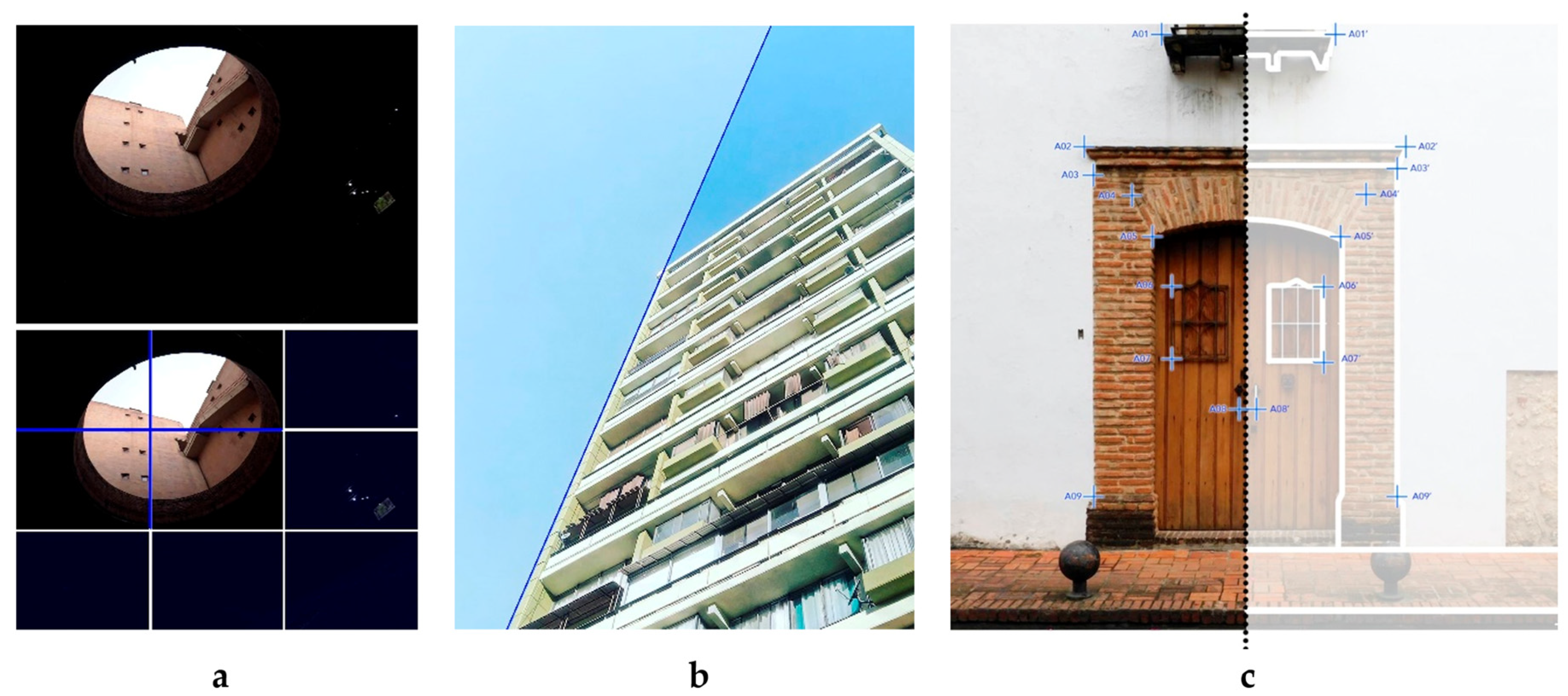


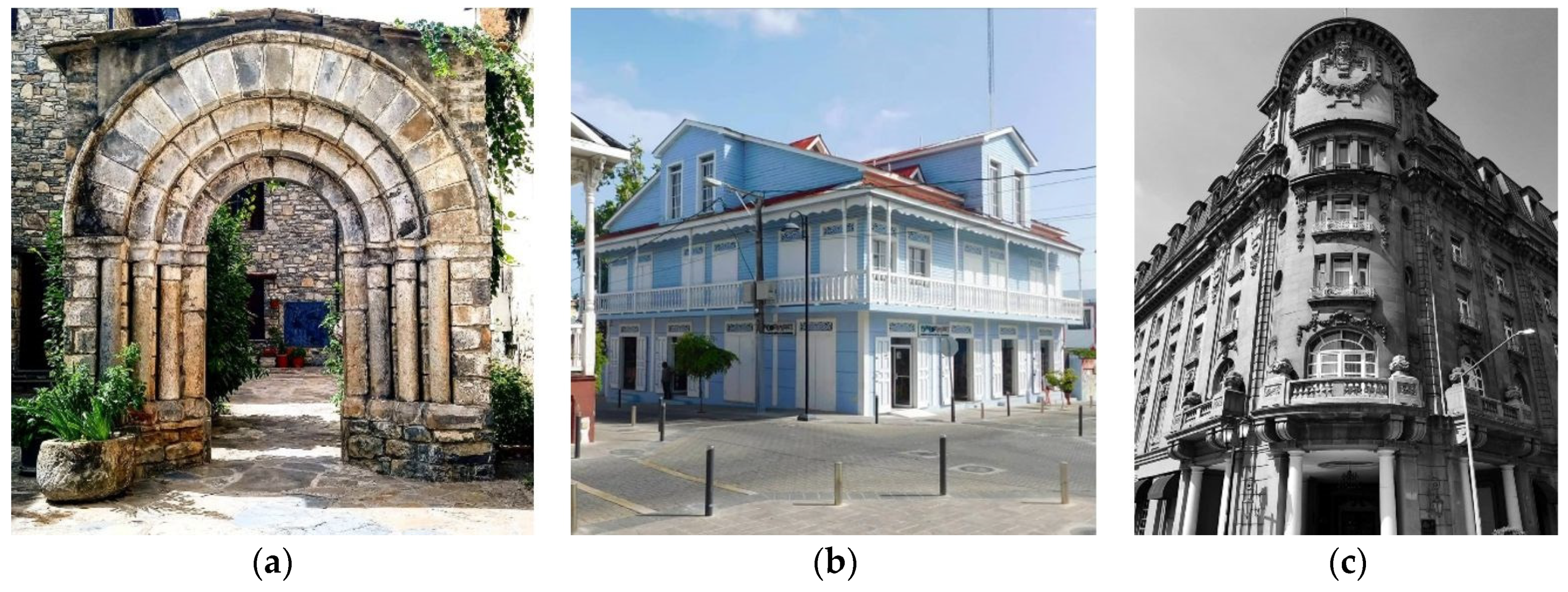

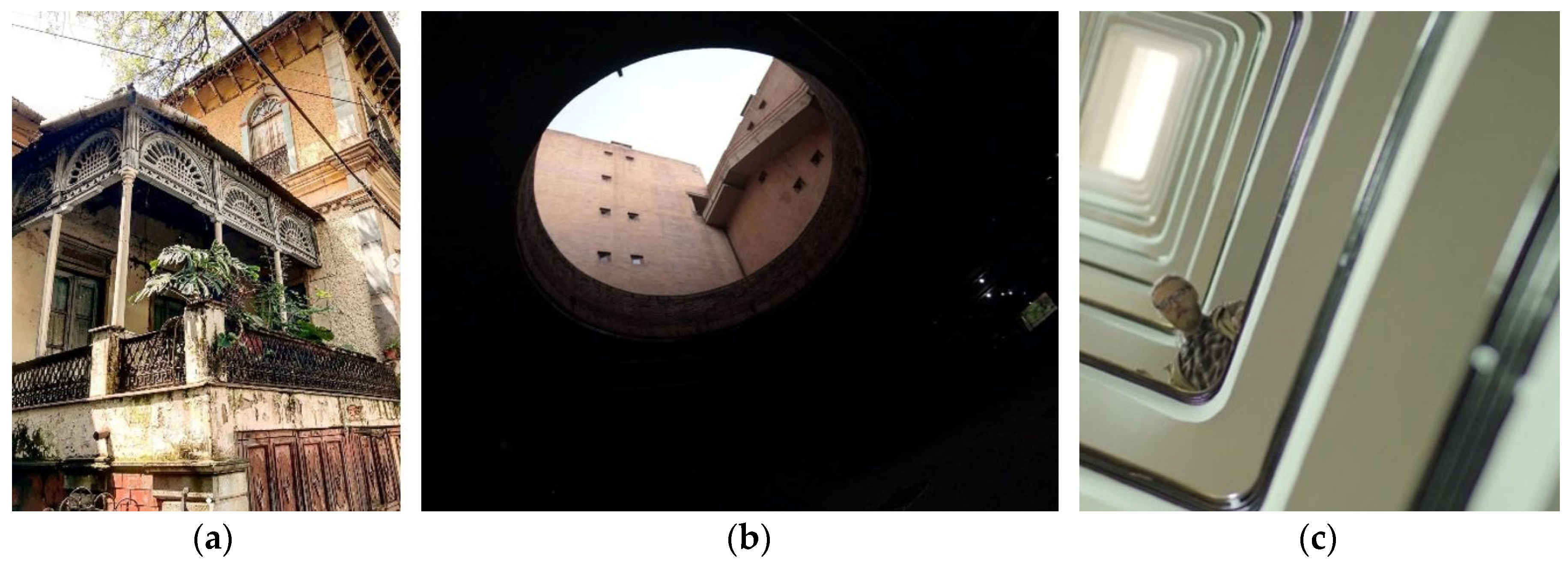
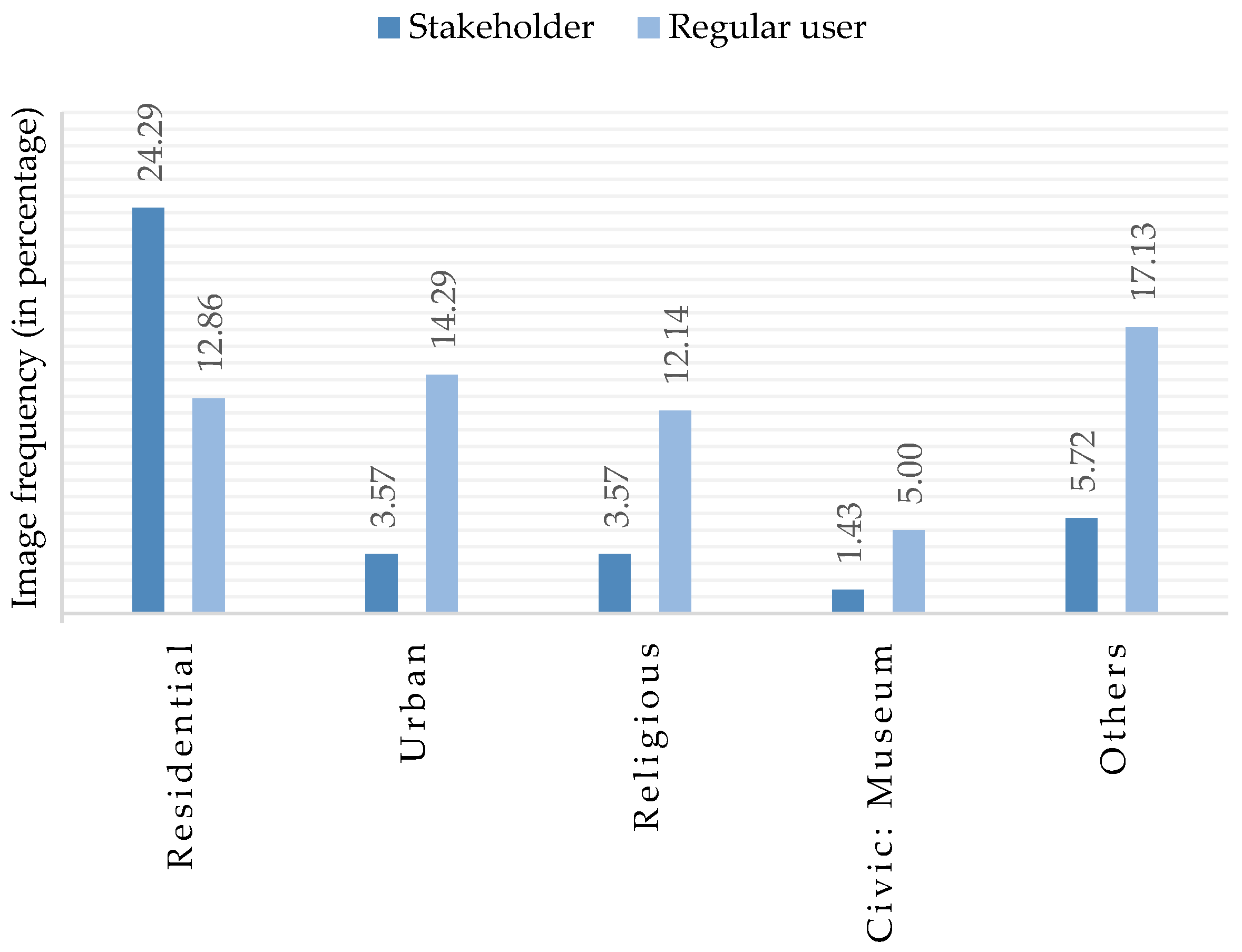
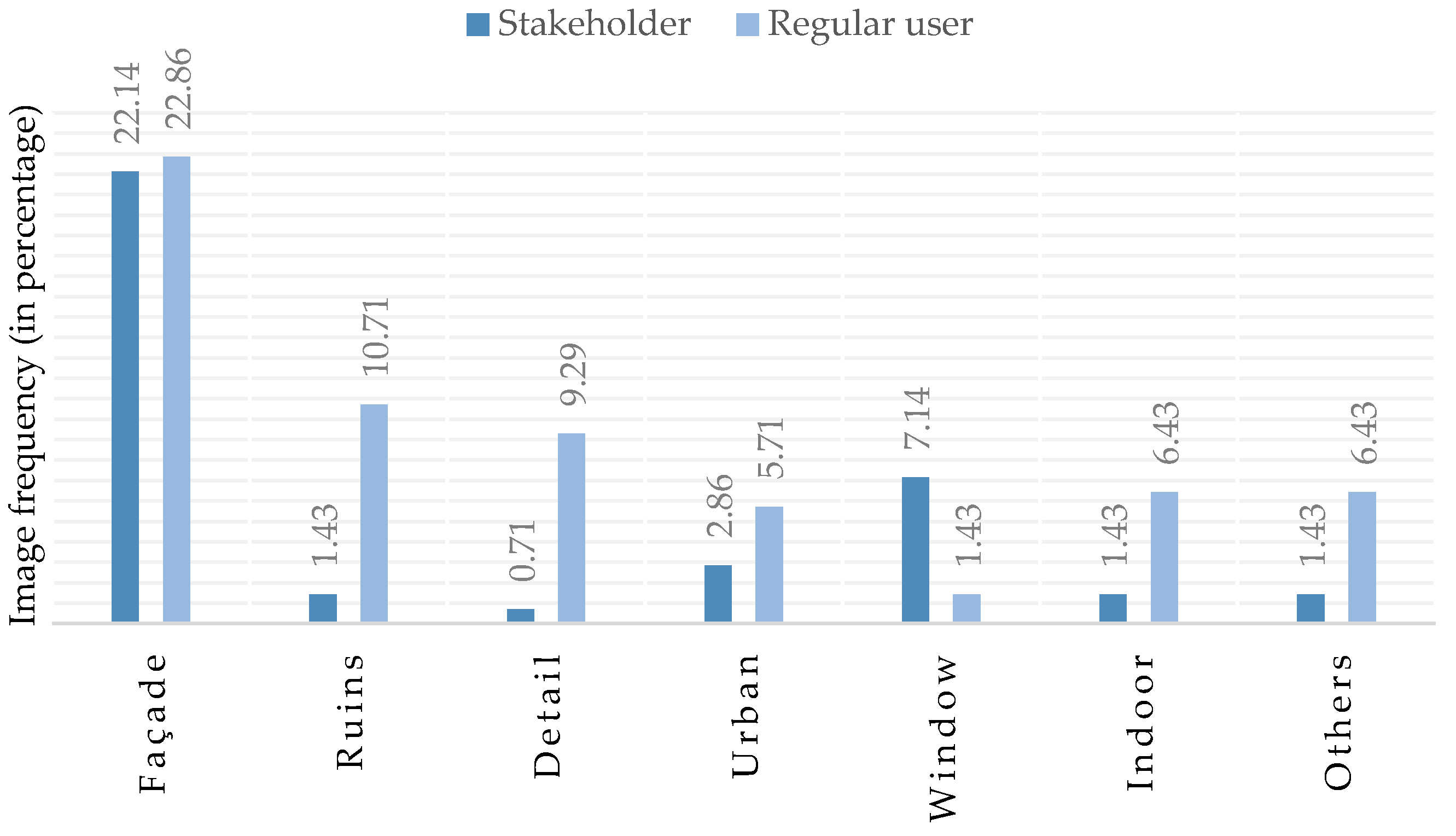
| Variable | Categories | Likes Test Results | Engagement Test Results | ||||
|---|---|---|---|---|---|---|---|
| Statistic | df | Sig. | Statistic | df | Sig. | ||
| Human dimension | Presence | 0.347 | 29 | 0.000 | 0.210 | 29 | 0.002 |
| Absence | 0.199 | 111 | 0.000 | 0.079 | 111 | 0.087 | |
| Color | Greyscale | 0.194 | 13 | 0.195 | 0.186 | 22 | 0.046 |
| Warm | 0.164 | 63 | 0.000 | 0.081 | 93 | 0.169 | |
| Cold | 0.238 | 16 | 0.016 | 0.096 | 25 | 0.200 | |
| Linear perspective | 1VPP | 0.206 | 38 | 0.000 | 0.086 | 57 | 0.200 |
| 2VPP | 0.227 | 41 | 0.000 | 0.159 | 63 | 0.000 | |
| 3VPP | 0.418 | 13 | 0.000 | 0.126 | 20 | 0.200 | |
| Aesthetic quality | Low | 0.259 | 60 | 0.000 | 0.111 | 60 | 0.065 |
| Medium | 0.292 | 60 | 0.000 | 0.125 | 60 | 0.020 | |
| High | 0.261 | 20 | 0.001 | 0.183 | 20 | 0.078 | |
| Variable | Categories | n | Mean Rank | Mann–Whitney U | Kruskal–Wallis H | Sig. |
|---|---|---|---|---|---|---|
| Human dimension | Presence | 29 | 55.64 | 1178.500 | - | 0.027 |
| Absence | 111 | 74.38 | ||||
| Color | Greyscale | 22 | 45.59 | - | 10.325 | 0.006 |
| Warm | 93 | 73.81 | ||||
| Cold | 25 | 80.12 | ||||
| Linear perspective | 1VPP | 57 | 86.25 | - | 15.000 | 0.001 |
| 2VPP | 63 | 61.44 | ||||
| 3VPP | 20 | 54.15 | ||||
| Aesthetic quality | Low | 60 | 67.60 | - | 0.741 | 0.690 |
| Medium | 60 | 73.86 | ||||
| High | 20 | 69.13 |
| Variable | (I) | (J) | Mean Difference (I–J) | Error Deviation | Sig. |
|---|---|---|---|---|---|
| Color | Grayscale | Warm | −53.607 | 28.452 | 0.147 |
| Cold | −89.011 | 35.082 | 0.033 | ||
| Linear perspective | 1VPP | 2VPP | 51.685 | 22.015 | 0.049 |
| 2VPP | 29.310 | 31.299 | 0.618 | ||
| Aesthetical quality | Low | Medium | −20.267 | 22.354 | 0.637 |
| High | −17.700 | 31.613 | 0.842 |
| Variable | Categories | n | Mean Rank | Mann–Whitney U | Kruskal–Wallis H | Sig. |
|---|---|---|---|---|---|---|
| Human dimension | Presence | 29 | 54.81 | 1154.500 | - | 0.019 |
| Absence | 111 | 74.60 | ||||
| Color | Grayscale | 22 | 87.59 | - | 4.941 | 0.085 |
| Warm | 93 | 66.24 | ||||
| Cold | 25 | 71.30 | ||||
| Linear perspective | 1VPP | 57 | 80.46 | - | 6.565 | 0.038 |
| 2VPP | 63 | 65.87 | ||||
| 3VPP | 20 | 56.73 | ||||
| Aesthetic quality | Low | 60 | 63.54 | - | 3.157 | 0.206 |
| Medium | 60 | 76.39 | ||||
| High | 20 | 73.70 |
| Variable | (I) | (J) | Mean Difference (I–J) | Error Deviation | Sig. |
|---|---|---|---|---|---|
| Linear perspective | 1VPP | 2VPP | 0.0264 | 0.0163 | 0.243 |
| 3VPP | 0.0522 | 0.0233 | 0.048 |
Publisher’s Note: MDPI stays neutral with regard to jurisdictional claims in published maps and institutional affiliations. |
© 2020 by the authors. Licensee MDPI, Basel, Switzerland. This article is an open access article distributed under the terms and conditions of the Creative Commons Attribution (CC BY) license (http://creativecommons.org/licenses/by/4.0/).
Share and Cite
López-Chao, V.; Lopez-Pena, V. Aesthetical Appeal and Dissemination of Architectural Heritage Photographs in Instagram. Buildings 2020, 10, 225. https://doi.org/10.3390/buildings10120225
López-Chao V, Lopez-Pena V. Aesthetical Appeal and Dissemination of Architectural Heritage Photographs in Instagram. Buildings. 2020; 10(12):225. https://doi.org/10.3390/buildings10120225
Chicago/Turabian StyleLópez-Chao, Vicente, and Vicente Lopez-Pena. 2020. "Aesthetical Appeal and Dissemination of Architectural Heritage Photographs in Instagram" Buildings 10, no. 12: 225. https://doi.org/10.3390/buildings10120225
APA StyleLópez-Chao, V., & Lopez-Pena, V. (2020). Aesthetical Appeal and Dissemination of Architectural Heritage Photographs in Instagram. Buildings, 10(12), 225. https://doi.org/10.3390/buildings10120225






